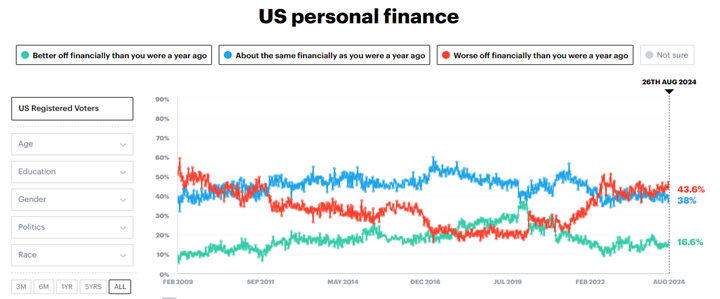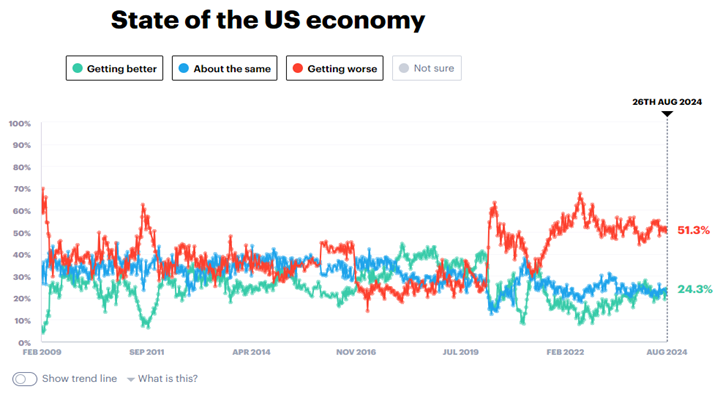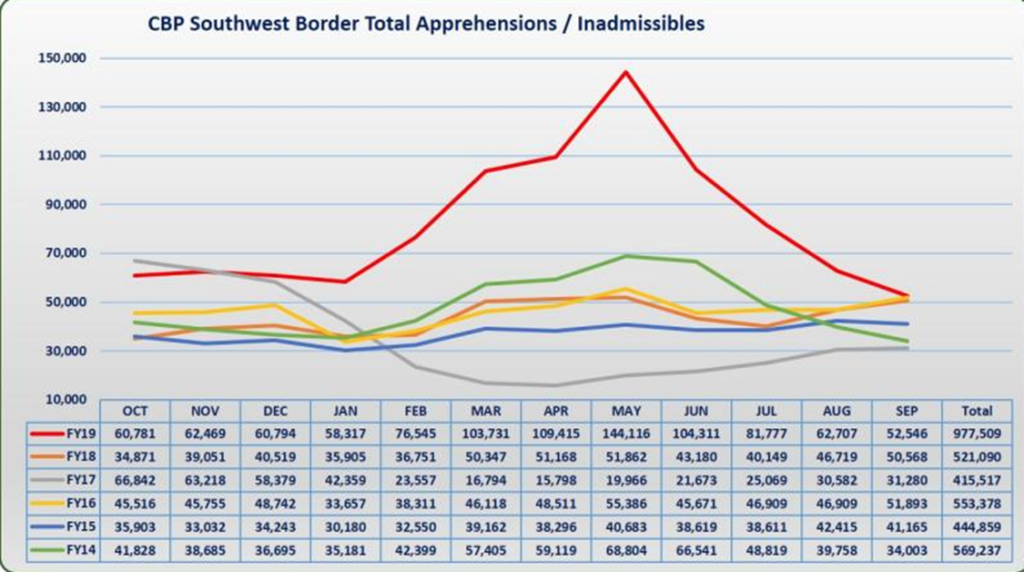
In the court of public opinion, President Biden and Vice President Harris receive their lowest marks on the economy and immigration. Do they actually deserve these low ratings? One way to find out is to scrutinize our prior conclusions by assuming it is us being evaluated, and not them. If it were you receiving these low marks, would you feel the evaluation was fair and just? If not, what else do you think needs to be considered to make the evaluation fair?
Let’s use the following hypothetical to get started on this exercise:
It’s spring 2024, and your boss pulls you in for a performance review. He cites concerns about your low sales numbers, noting they were only 50% of average in 2022, and 75% of average in 2023. You know he understands that sales conditions were bad during 2022 and 2023. All the sales reps in your company and the industry in general were struggling during those years. But he’s blaming you for poor results and wants to see a turnaround within six months.
You work very hard for six months and get your sales numbers back to 100% of average. Your boss pulls you in for a review and terminates you. He keeps harping on your sales numbers from 2022 and 2023. He doesn’t want to talk about the turnaround you just pulled off in the last six months. Instead, he informs you that he’s going to replace you with a candidate with good sales numbers from several years ago, when business happened to be booming. That candidate, by the way, told your boss that your sales numbers were a disaster and that you should be replaced.
Americans are negative about the economy mostly because of our struggles with personal finances, which we tend to blame the Biden Administration for causing or neglecting to fix.
Since the Covid-19 pandemic, Americans tend to be gloomy about their personal finances. EconomistYouGov tracks how Americans feel about their personal finances compared to a year ago: better off financially, about the same financially, worse off financially, or not sure. Going back 15 years (see below), it’s clear we are particularly gloomy since late 2021.

With the start of the Covid-19 pandemic (early 2020) there was a spike in the “worse off financially”(red) and a drop in “better off financially” (green). Around the time Biden came into office, the percentage for “worse off financially” started to climb again. It went from 22% (January 2022) to a peak of 48.2% in August 2022. For the two years since then the percentage for “worse off financially” hovers around 40%. You have to go back to the Great Recession of 2008-09 to find a higher level of pessimism regarding personal finances. Clearly, since the pandemic, a relatively high percentage of Americans are feeling worse off financially.
When we examine perceptions on the State of the US economy (see below), we see they mirror perceptions regarding personal finances. Put simply, the status of our personal finances influences how we see the economy. In 2009, 60% felt their personal finances were “worse off” and 70% saw the US economy as “getting worse.” During the latter part of the Obama Administration (2016) and the early Trump Administration, most Americans saw the economy as “about the same” or “getting better.” With the surge in the Covid-19 pandemic (May 2020), around 63% saw the economy as “getting worse.” This gradually dropped to around 30% early in the Biden Administration (May 2021). But thereafter, perceptions of “getting worse” peaked at 67.5% in June 2022 (when inflation peaked at 9.1%). For over two years, the percentage of those feeling the economy is “getting worse” has ranged between 44% and 62% (currently at 51.3%).

When we compare our perceptions of the US economy with the actual facts regarding the economy, there is a striking disconnect:
- The US is the world’s largest economy, and it made the strongest recovery among G-7 countries since the pandemic.
- Since peaking in June 2022 at 9.1%, the inflation rate dropped to 3% by June 2022; and it has been in the 2.9% to 3.7% range for over a year.
- Wages are growing above the rate of inflation since February 2023 (20 months).
- Since Biden came into office, over 15 million new jobs have been created, and unemployment remains at or close to historic low levels.
- Stock market returns are very strong.
- Many economists are predicting a very difficult to achieve “soft landing,” as the US has largely tamed inflation without triggering a recession.
- The Federal Reserve is poised to start lowering interest rates in September. Doing so will encourage both consumer spending and business investment. This should result in lower interest rates on mortgages, car loans and credit cards.
In a previous article I explored this disconnect. I found that perceptions regarding the economy and the Biden Administration’s handling of it are indeed influenced by the status of our personal finances. In addition, I found many Americans are influenced by Donald Trump’s messaging campaign that falsely pins blame on the Biden Administration for our struggles with personal finances. In particular, Trump and Republicans repeatedly assert that Biden and Harris are totally responsible for high inflation we suffer every day. And, finally, the media’s tendency to focus on the negative exacerbates our gloomy views regarding the economy.
In summary, it’s perfectly understandable why so many Americans are so down about their personal finances, the condition of the economy, and the Biden Administration’s handling of it. We continue to be shocked by high grocery, gas, housing and energy costs. Our credit card rates are too high and we’re in too much debt. It’s hard for us not to want to blame someone for all these hardships. And all the good news about the economy doesn’t seem real and hasn’t yet translated to improved personal finances. It’s not a big leap to want to blame Biden and Harris for causing our struggles or not fixing the problem.
To assess whether we’re judging Biden and Harris unfairly regarding the economy, let’s scrutinize our prior conclusions using the hypothetical set forth above.
Most of us would find it unfair or unjust to be fired for a problem we did not create. And, as to a problem we are asked to address, we’d surely see it as unfair to be terminated absent any consideration of our efforts to fix the problem. Just as you wouldn’t want to be fired on the basis of your 2022 and 2023 sales numbers, you wouldn’t want to be fired based on an inflation rate that peaked over two years ago. In fairness, you’d want us to consider the progress in taming inflation and all the other positives that have produced the world’s strongest economy. And, finally, just as it would be unfair to fire you in favor of someone who falsely condemned your sales numbers, you wouldn’t want to be fired on the basis of your political opponent’s false claims that you caused the financial hardships that Americans suffer.
In prior analyses, I showed that Biden’s spending was not the sole or primary cause of high inflation. Yes, spending by the Biden Administration had some effect on inflation. But most of it was caused by supply chain problems, labor supply problems, Russia’s invasion of Ukraine, and corporate profiteering. High inflation was occurring around the world, not just in the US. Thus, it is unfair and false to negatively evaluate Biden and Harris on the basis that they were the sole or primary cause of high inflation.
Furthermore, since June of 2022, the inflation rate dropped from a high of 9.1% to 3% or less. Inflation is largely tamed, and this progress should be recognized in evaluating Biden and Harris. There are other areas of significant progress. Wages are consistently above the rate of inflation. Unemployment remains at historically low levels. The gross domestic product (GDP) is steadily growing at strong levels. And, a record number of new jobs have been added. The positive changes in these critical economic indicators should be recognized in evaluating Biden and Harris on the economy.
Finally, while it is true that many of us are struggling with our personal finances, most of these struggles are due to actions of the Federal Reserve (Fed), or actions by other entities not under the control of the President. The Fed aggressively raised interest rates in order to tame inflation. The increased rates led to higher credit card rates, higher mortgage rates, and higher borrowing rates for big ticket items. The Federal Reserve is an independent entity, and the President does not control its actions. So, yes, many of us are struggling with our personal finances because of the Fed’s actions. But these actions are part of the tough medicine required to fix the problem. It is thus unfair for us to blame Biden and Harris for actions of an independent entity aimed at fixing the problem. Rather, if we look beyond our struggles, we’ll see that the inflation situation is much improved, and that our personal finances are likely to improve in the near-term future.
Americans also suffer in their personal finances because of the high cost of groceries, gasoline, housing, energy, and other commodities. The costs for these items has shot up in most countries of the world, and not just in the US. More important, the President has no direct control of prices for these items. It is thus unfair to blame Biden and Harris for failing to lower these prices.
When we examine past efforts to tame high inflation, our most recent effort stands out as both successful and quick. In the space of just over 2 years, inflation went from 2.6% (March 2021), to a peak of 9.1% (June 2022), and back down to 3% (June 2023). It took over 4 years for inflation to go from 3.2% (September 1972), to a peak of 12.2% (November 1974), and back to 5% (December 1976). And, starting in 1978, it took over 5 years for inflation to go from 6.4% (March 1978), to a peak of 14.6% (March 1980), and back down to 2.36% (July 1983).
In summary, there is strong evidence that many of us judge Biden and Harris unfairly when it comes to the economy. It’s understandable why we are prone to be negative regarding their efforts. Many of us are still hurting financially and many of us are influenced by the messaging campaign of Trump and the Republicans. But the Biden administration is not primarily responsible for creating high inflation. Nor should it be blamed for the tough medicine consequences coming from the Fed’s efforts to tame inflation. Inflation has, in fact, been controlled quickly and completely. And our struggles with personal finances should be improving in the near term.
As to illegal immigration, it’s understandable that so many of us are negative about the Biden Administration’s performance given the huge increase in “illegal border crossings” and the fact that so many of these crossers are allowed to stay in the US instead of being removed or expelled.
The video and photographic evidence of throngs of immigrants at the Southern Border is damning. Trump and the Republicans are relentless in characterizing Biden’s “open borders” where migrants are waived into the country, briefly detained, and then allowed to disappear into the interior (“catch and release”). It’s an “invasion,” they say.
The basic metric used to document this huge increase in crossings is data on “encounters” or “apprehensions” maintained by US Customs and Border Protection (CPB). Trump and the Republicans use these “encounters” to quantify the total number of “illegal immigrants” in a given year.
Below I show the latest CPB graphic on “Nationwide Encounters” since the time Biden has been in office:

As you can see, there were:
- 1.957 million encounters in 2021 (blue line),
- 2.767 million encounters in 2022 (gold line),
- 3.201 million encounters in 2023 (black line), and
- 2.598 million encounters so far in 2024 (orange line).
This totals some 10.5 million encounters during the time Biden has been in office.
Data is also reported in terms of “Southwest Land Border Encounters.” During Biden’s term of office so far (July 2024), there have been 8.516 encounters at the Southwest Land Border. This compares with 1.914 million encounters at the Southwest Land Border during the time Trump was in office. Republicans especially point to 2020, the last year Trump was in office, when there were only 400,651 encounters at the Southwest Land Border. Trump and Republicans use these figures to prove that they had total control of the border, and that all this progress was lost under Biden.
Some Republicans claim that about 85% of those encountered are released (“catch and release”) to await further immigration processing. But the Center for Immigration Studies, a conservative and anti-immigration think tank, puts the total number at 2,020,052 as of April 2023. Analysis by FactCheck.org puts the percentage at 35% during the time Biden has been in office, which translates to about 3.675 million. Court proceedings to determine the fate of these individuals can take up to five years. And, as of November 2023, there was a backlog of over 3 million cases in the immigration courts.
Finally, in addition to those who are caught and released, we also need to count the migrants who evade apprehension (sneak into the country without being caught) and remain in the country illegally. These are called “detected gotaways,” and the Department of Homeland Security annually estimates them as a part of its Border Security Metrics Report. FactCheck.org puts the number of “detected gotaways” during Biden’s term at around 1.6 million. This compares with some 521,000 “detected gotaways” during Trump’s term. Caution should be used in comparing these numbers because the high numbers during the Biden Administration happened during the period when Title 42 expulsions were in effect. Detected gotaways have dropped since the end of Title 42.
In summary, so long as our main criteria for assessment are the huge increase in the number of “encounters” and the huge number of migrants who are allowed to stay in the US after being detained and processed, it’s understandable why many Americans are negative about the Biden Administration’s handling of illegal immigration. On the other hand, do these numbers tell the whole story? What else do we need to know about the Biden Administration’s efforts on immigration, including recent efforts that have drastically reduced the number of encounters?
To assess whether we’re judging Biden and Harris unfairly regarding illegal immigration, let’s scrutinize our prior conclusions, again using the hypothetical.
When we scrutinize our prior conclusions we find that Biden and Harris are being judged unfairly for at least six reasons:
First, it’s wrong and misleading to equate the number of “encounters” with the number of “illegal border crossers.” A migrant seeking asylum is not an “illegal immigrant.” Rather, asylum is a process for legal immigration into the US. Migrants can seek asylum by surrendering themselves at the border. They can also seek asylum after being apprehended by the Border Patrol (“defensive asylum”). On the other hand, all of those seeking asylum, either affirmatively or defensively, are counted as “encounters.” So far during the time Biden has been in office, 1,183,126 migrants applied for asylum. This number constitutes more than 11% of all encounters during Biden’s term in office.
In addition, “encounters” shouldn’t be conflated with “illegal border crossers” because refugee admissions are also counted as encounters. For instance, as of February 2023, more than 271,000 Ukrainian refugees had been admitted to the US since Russia’s invasion of Ukraine in February 2022. Surely, we wouldn’t want to count these refugees as “illegal aliens.”
Second, it’s problematic to compare Trump’s record regarding “encounters” with Biden’s record because conditions were very different during the two Administrations. Comparing Trump’s last year (2020), with only 400,651 encounters, is especially a problem because the entire world was in the grips of the Covid-19 pandemic and recession. Migration slowed all around the globe, as people simply weren’t travelling and there were no jobs. Contrast this with Biden’s Administration where the US emerged from the pandemic with robust economic growth and huge numbers of job openings. Migrants flocked to the US, which resulted in a record number of “encounters” at the border.
If we look at Trump’s entire tenure, and especially 2019, the difference in encounters is not so stark. Here’s Trump’s record, by fiscal year, for the Southwest Land Border:

As you can see, there were 977,509 encounters in 2019, 521,090 in 2018, and 415,517 in 2017. With the US economy being very strong in 2019, migrants from around the world decided to immigrate to the US. There were almost 1 million encounters, despite Trump’s full court press to end illegal immigration. The number of encounters essentially doubled over counts from prior years. Had there not been the Covid-19 pandemic and recession, one can only guess how many migrants would have come to the US in 2020.
Third, the fact that there was a very large increase in encounters doesn’t prove the Biden Administration caused or encouraged this increase. No one would argue that President Trump caused or encouraged the huge increase in encounters that occurred in 2019. Rather, the increase occurred because neither the President nor Congress can prohibit a person from deciding to travel to the US and attempting to enter legally (asylum), or illegally. Yes, it is undoubtedly true that many migrants decided to come to the US because Trump was out of office. Many migrants may have thought the Biden Administration might be more receptive to their entry. But the Biden Administration neither asked them to come nor promised them unfettered entry. Instead, it apprehended migrants in record numbers and processed them in accordance with federal law. In fact, the Biden Administration adopted numerous executive actions to bring more control to the situation at the border.
Fourth, and closely related, the fact that there was a large increase in encounters as well as large increase in those briefly detained and then released into the interior (“catch and release”) doesn’t prove the Biden Administration isn’t removing and expelling migrants in accordance with law. Below is a table from latest version (2022) of the Yearbook of Immigration Statistics:

As you can see, the Biden Administration expelled 1,071,074 migrants in 2021, and 1,103,966 in 2022. It also removed, administratively returned, and otherwise returned over 600,000 migrants in these two years. A separate report for 2023 shows 142,580 removals and 62,545 expulsions during that year. The total removals and expulsions for these three years sits at almost 3 million (2,980,165).
It’s also important to recognize that federal law, particularly with respect to asylum, provides migrants with due process protections, including court hearings and formal administrative determinations. The President cannot ignore these laws. With the huge influx of migrants at the border, the Biden Administration had limited options. Neither it nor the Trump Administration had the resources to detain hundreds of thousands of migrants during the pendency of their proceedings. The Trump Administration implemented a “Remain in Mexico” policy to detain migrants in that country. However, the capacity of this program was limited (70,000), it was legally challenged, and the Mexican government eventually ended its participation. This left the option of detaining migrants, providing them a court or hearing date, and then releasing them. This option was neither preferred nor ideal. Since the immigration courts also had limited resources, huge backlogs developed starting during Trump’s term and accelerating during Biden’s.
Fifth, the Biden Administration has persistently called for congressional action to fix the broken system. It sought more funding for the Border Patrol and enforcement. It sought to reform immigration laws, especially with respect to asylum, to streamline legal procedures and to give the President and federal government more power to close the border. It asked for resources to reduce or eliminate immigration court backlogs. And, perhaps most important, the Biden Administration argued that executive action alone cannot fix the problems. Many of Trump’s executive orders were overturned, and many of Biden’s actions have also been legally challenged. The Biden Administration correctly argues that clear statutory authority from Congress is needed to give the President broad authority to act.
Most recently, in February of this year a major bipartisan reform measure was hammered out between Republicans and Democrats. This proposal gave the President clear legal authority to close the border. It also provided resources to hire more enforcement personnel and resources to reduce court backlogs. It even streamlined asylum procedures. Trump, however, told his congressional colleagues to reject the measure, and he took credit for killing it.
Sixth, and finally, the Biden Administration took executive action on June 4th to shut down asylum requests when encounters at the border reach specified levels. Also, those seeking asylum are essentially required to pre-apply and secure an appointment. Otherwise, they are turned away. This executive order was immediately challenged in court, and its fate is uncertain. Recent reports show that encounters at the southwest border have dropped 55% and more than 65,000 have been returned in the weeks since the order was adopted.
In summary, there is strong evidence that many of us are judging Biden and Harris unfairly when it comes to unauthorized immigration. The number of illegal crossings is seriously overstated by conflating this statistic with “encounters.” The Covid-19 pandemic dramatically reduced migration and encounters in 2020; and the strong economic recovery in 2021 and thereafter had the effect of increasing migration and encounters. Also, almost 3 million of those encountered have been removed and expelled. Millions more have been detained and then released, to await court proceedings and due process procedures fixed in law. In the face of a huge increase in encounters, Congress has denied Biden’s requests to increase enforcement personnel, increase detention facilities, reduce court backlogs, streamline asylum procedures, and provide the President with clear authority to close the border. Donald Trump and the Republicans specifically blocked a major bipartisan compromise that would have addressed many of the problems.
Finally, the Biden Administration recently adopted an executive order that significantly reduced the number of encounters and that attempts to bring more order to processing immigration cases. The order has been legally challenged and is vulnerable given other rulings against the Trump and Biden Administrations on similar immigration matters. The bipartisan compromise blocked by Trump and the Republicans would have squarely authorized executive orders such as the one Biden adopted.
In choosing our next President, we should be mindful that we may have misjudged Biden and Harris when it comes to their efforts on the economy and illegal immigration.
Just as you would want to be treated fairly when your performance is evaluated, Biden and Harris deserve the same treatment. The evidence is clear that many of us have graded them unfairly by using limited or inappropriate criteria to assess their performance. By putting ourselves in their shoes and scrutinizing our prior conclusions we see that the economy has actually done well, inflation has been tamed, and better days are ahead for our personal finances.
As to illegal immigration, we have been misled by faulty data comparisons. The Biden Administration was confronted with a huge influx of migrants, and it has struggled to enforce the law within the confines of limited resources and outdated laws. Republicans rejected bipartisan compromise that would have improved enforcement. Through executive action the Biden Administration drastically reduced encounters; but this action may not survive judicial scrutiny.
When all is said and done, you get to make up your own mind. This article simply asks us to reflect on whether we have been unfair in evaluating the Biden Administration on the economy and illegal immigration. My analysis says Biden and Harris have been judged unfairly and deserve better marks. If you agree, please take this conclusion to the ballot box in November.
Leave a Reply